Menus
- Superbike Comparison, Part 2: Racetrack
- Almost on par in terms of weight
- One would like to sit higher on the BMW S 1000
- The driver must be able to move quickly
- Cushioning systems are of great help
- First or second gear?
- Wheelie controls even asked for on the downhill straights
- First signs of weakness
- Yamaha YZF-R1M wins the brake comparison
- The fastest production superbikes of all time
- Recording
- BMW and Yamaha almost as fast as the Aprilia
- Set up
- Technical specifications
- Performance measurements
- MOTORCYCLE race track ranking
- MOTORCYCLE test result
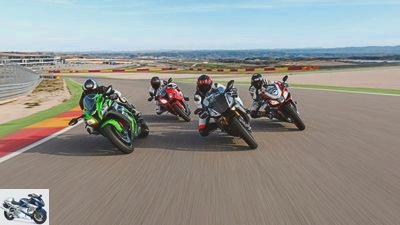
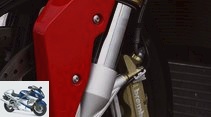
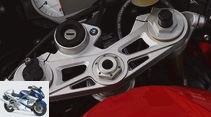

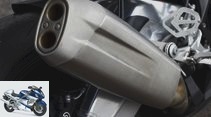
51 photos
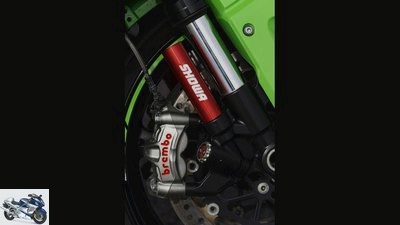
1/51
The kawa brake was transformed. She looked dull and lacked exact feedback.
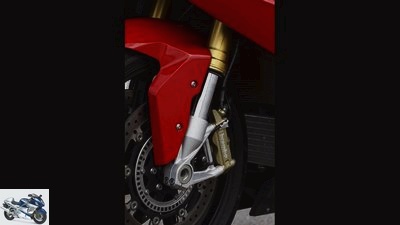
2/51
The brakes of the S 1000 RR decelerate with power and yet easily controllable. But once the pressure point moved.

3/51
BMW S 1000 RR.
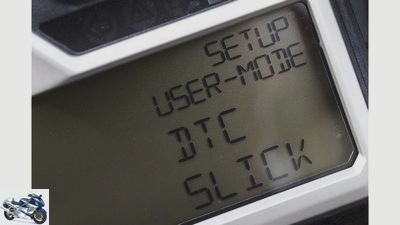
4/51
BMW S 1000 RR.
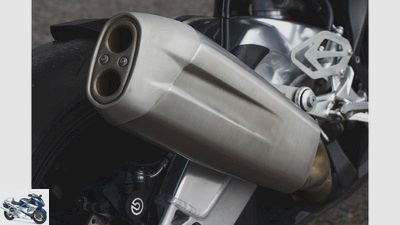
5/51
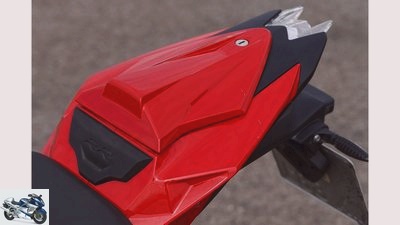
6/51
BMW S 1000 RR.

7/51
BMW S 1000 RR.
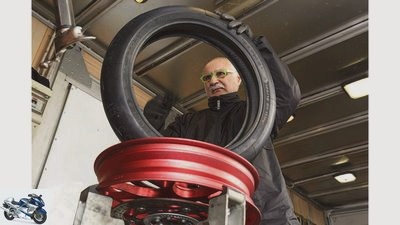
8/51
N. n. And his colleagues from the Metzeler / Pirelli test department had to assemble twelve sets of tires for this test. As usual, they did this additional job meticulously and quickly.

9/51
Aprilia RSV4 RF, BMW S 1000 RR, Kawasaki ZX-10R and Yamaha YZF-R1M.
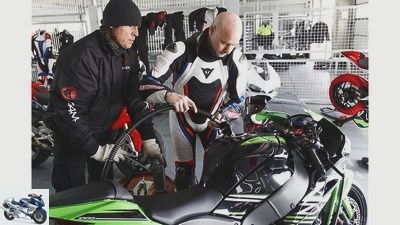
10/51
Kawasaki ZX-10R.
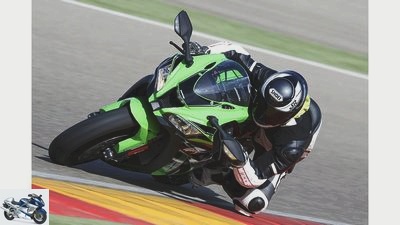
11/51
The ZX-10R impresses with its safe front wheel guidance. Here at full steam downhill in third gear.
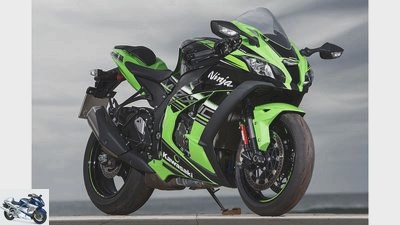
12/51
Kawasaki ZX-10R.
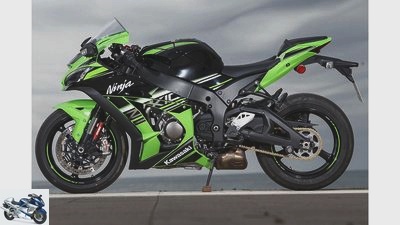
13/51
Kawasaki ZX-10R.
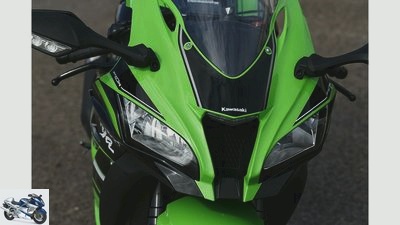
14/51
Kawasaki ZX-10R.
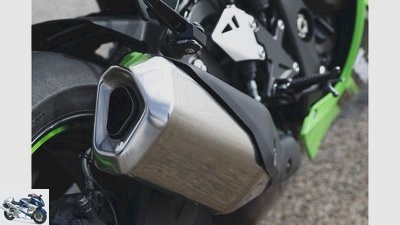
15/51
Kawasaki ZX-10R.
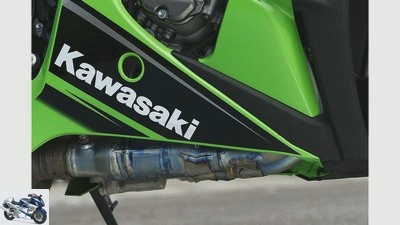
16/51
The Kawasaki manifold is certainly not a design object. But a part made with great craftsmanship from fine, lightweight titanium.
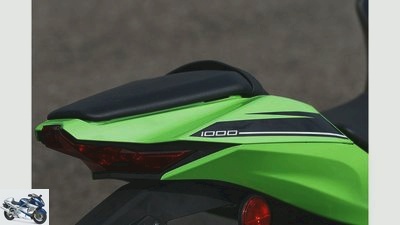
17/51
Kawasaki ZX-10R.

18/51
As with the R1, the shift pattern of the S 1000 RR can easily be reversed. Unfortunately, the shift assistant gradually failed in the test.
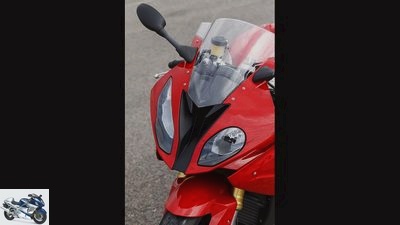
19/51
BMW S 1000 RR.
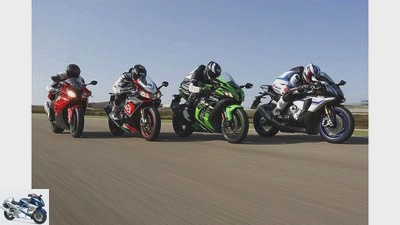
20/51
In Motorland Aragon, the superbikes can fully unfold.
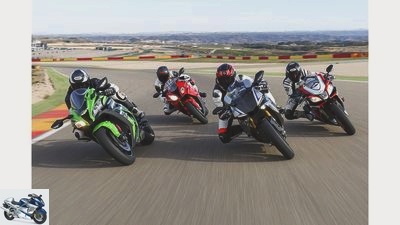
21/51
Aprilia RSV4 RF, BMW S 1000 RR, Kawasaki ZX-10R and Yamaha YZF-R1M are in competition.
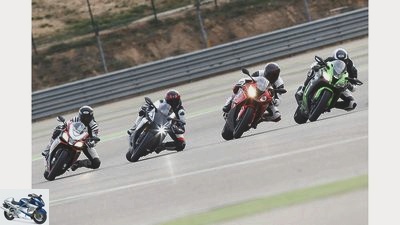
22/51
The current four-cylinder superbikes. There’ll be more supplies next year.
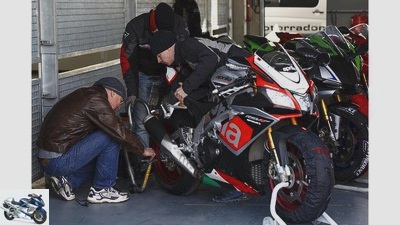
23/51
Aprilia RSV4 RF.
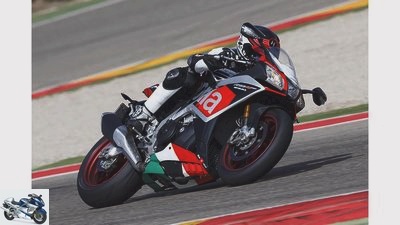
24/51
A fantastic combination in Aragon: the Aprilia and a fast left-right curve sequence.
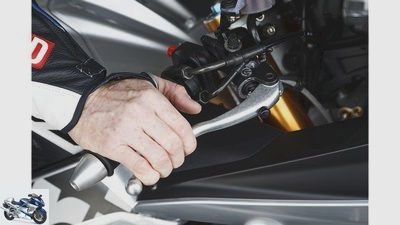
25/51
Only after bleeding and changing the brake lever did the pressure point remain stable at this distance from the handlebars.
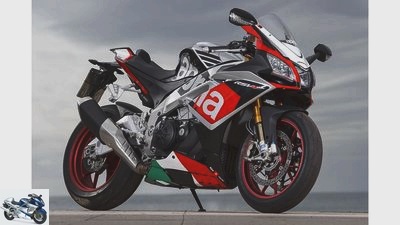
26/51
Aprilia RSV4 RF.

27/51
Aprilia RSV4 RF.
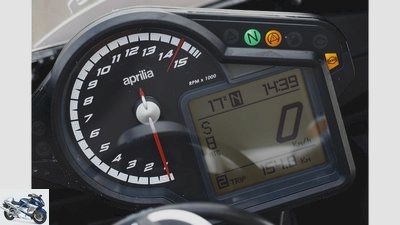
28/51
Aprilia RSV4 RF.
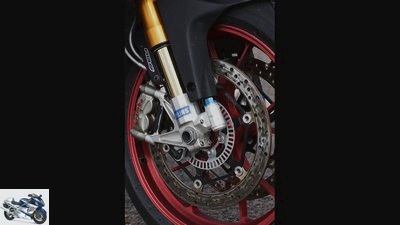
29/51
With a thickness of just under 4.5 millimeters, the RSV4’s brake discs are the thinnest. You look stressed.
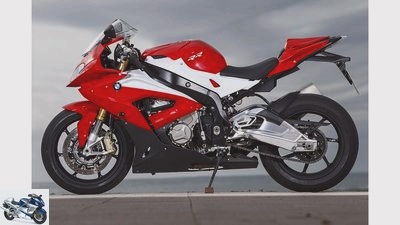
30/51
BMW S 1000 RR.
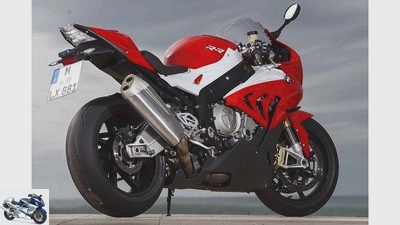
31/51
BMW S 1000 RR.
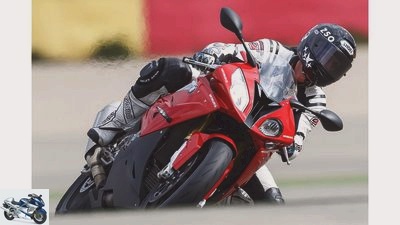
32/51
Christian Kellner puts pressure on the S 1000 RR. He likes to tilt the horizon.
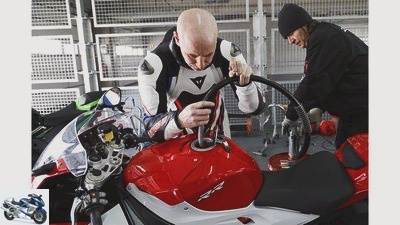
33/51
BMW S 1000 RR.
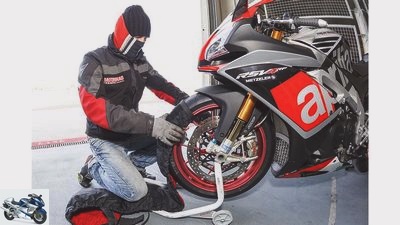
34/51
Aprilia RSV4 RF.
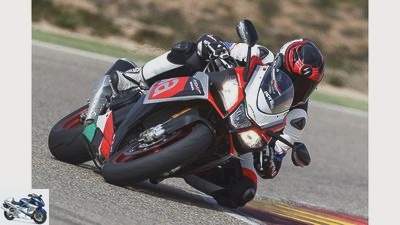
35/51
Aprilia RSV4 RF.
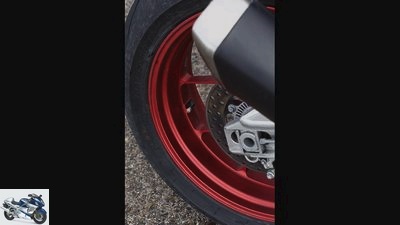
36/51
Aprilia RSV4 RF.
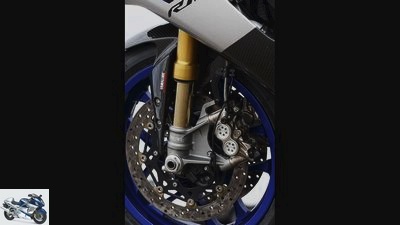
37/51
The stress can also be seen in her. But the Yamaha brakes were not impressed.
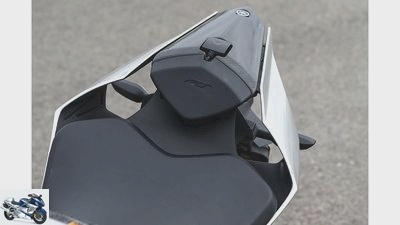
38/51
Yamaha YZF-R1M.
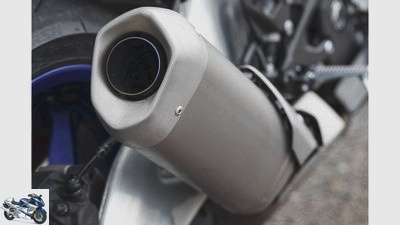
39/51
Yamaha YZF-R1M.
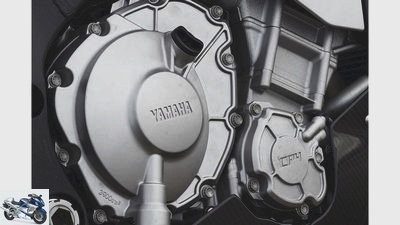
40/51
Yamaha YZF-R1M.

41/51
This GPS receiver supplies the information for an internal recording. The software for this is available when you buy the machine.

42/51
Whenever things get fast and weird, the R1 is right at the front. Your chassis is great.
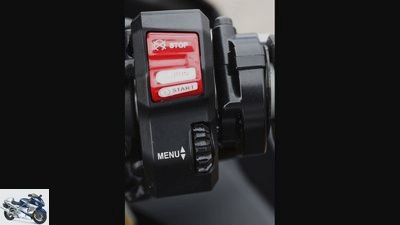
43/51
Yamaha YZF-R1M.
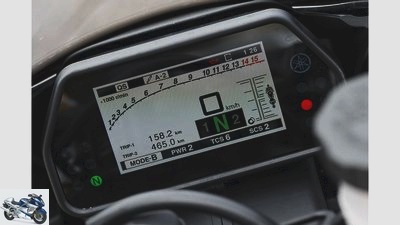
44/51
Yamaha YZF-R1M.
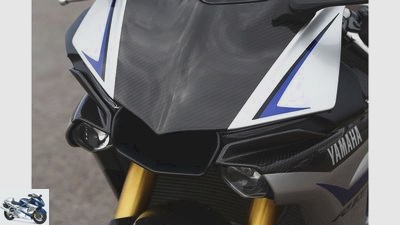
45/51
Yamaha YZF-R1M.
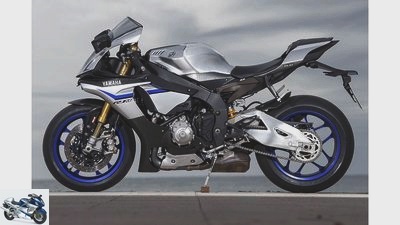
46/51
Yamaha YZF-R1M.
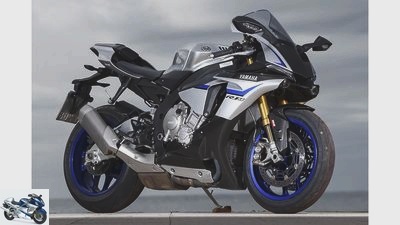
47/51
Yamaha YZF-R1M.
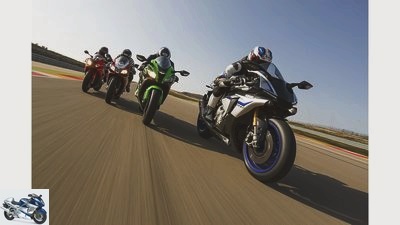
48/51
It’s going downhill here, even with a tailwind in the tests. Result: almost 290 km / h from the braking point.

49/51
Kawasaki ZX-10R.
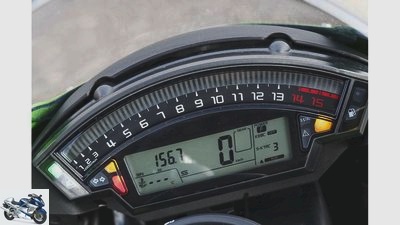
50/51
Kawasaki ZX-10R.
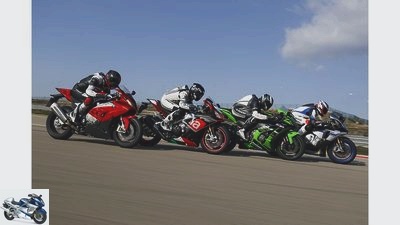
51/51
Tunnel vision instead of a view: the route attracts everyone’s concentration.
Aprilia RSV4 RF, BMW S 1000 RR, Kawasaki ZX-10R and Yamaha YZF-R1M in the test
Superbike Comparison, Part 2: Racetrack
The Grand Prix circuit in Aragon is particularly fascinating because of its fast corners. The qualities of modern superbikes can unfold there. It feels like floating at the highest speed. Part 2 of the great Superbike comparison test with the Aprilia RSV4 RF, BMW S 1000 RR, Kawasaki ZX-10R and Yamaha YZF-R1M models.
M.otorland Aragon: The first corner, a left bend, forces you to brake sharply and slow down. With the concentration on the right line, the field of vision narrows; it seems as if one is squeezing through a narrow alley. Then you go right into the sun. It is low now in the spring and gleams painfully, but it makes the asphalt strip blink. It goes uphill in a long right turn, then there is another right curve, a hilltop. Don’t let it be carried too far to the left, pull to the right, keep on the gas, keep going, keep going – now! At around 120 km / h, the motorcycle is jagged to the left, sweeps over the inner curbs in a full incline and arrows towards the next tight left.
Buy complete article

Aprilia RSV4 RF, BMW S 1000 RR, Kawasaki ZX-10R and Yamaha YZF-R1M in the test
Superbike Comparison, Part 2: Racetrack
RSV4 RF and the Yamaha YZF-R1M. With their high seat cushions and low handlebar halves, they were more strenuous to drive on country roads than the BMW S 1000 RR and Kawasaki ZX-10R. Here on the racetrack, however, at a high basic speed, they unfold their full and fascinating potential in terms of maneuverability and steering precision.
Almost on par in terms of weight
What gives the two superbikes Aprilia RSV4 RF and Yamaha YZF-R1M their special talent cannot be explained with the technical data that the manufacturers reveal. The chassis geometries of the two differ only slightly from each other and from those of the Kawasaki ZX-10R and the BMW S 1000 RR. Their short lag of 96 millimeters is the greatest deviation from the other three, which are between 102 and 107 millimeters. In terms of weight, all four are in the range of seven kilograms, and the weight distribution also differs little.
Rather, it must be due to the location, in particular the greater height of the center of gravity of Aprilia and Yamaha, which is indicated by stately seat heights of 835 and 840 millimeters. The aluminum tank of the Yamaha YZF-R1M, which only rises gently towards the rear, or the short, narrow tank of the Aprilia RSV4 RF provide further indication of what the developers had in mind. They make it easier for the driver to shift his weight far forward and into the inside of the bend when cornering, and to use it more efficiently in every situation. The very wide rear tires and the enormous acceleration of the motorcycles, whose wheelbases have not or hardly been extended in recent years, demand this.
One would like to sit higher on the BMW S 1000
The potentially lower braking stability of this design does not affect the Aprilia RSV4 RF. It bears most of the weight at the back, and the somewhat longer spring travel and thus also the downstroke should help it a little. The Yamaha YZF-R1M lifts off faster and more often when braking sharply into corners; thanks to the semi-active adjustment of the damping, the M version is more vigorous than the standard model. Front compression closed, rear rebound open – this is how the problem is alleviated.
Even more than after a long tour on the country road, it is noticeable with the BMW S 1000 RR that you would like to sit a little higher, “actively”. Especially on this one, which accelerates the most brutally, it is more difficult than on the other motorcycles to resist. Anyone who looks at Markus Reiterberger’s current World Championship Superbike or the racing motorcycles from earlier years will notice that they are all equipped with higher seat cushions than the standard versions. With a distribution of 52.6 percent at the front and 47.4 percent at the rear, the BMW puts the most weight on the front wheel when stationary, and it probably needs that too.
The driver must be able to move quickly
Of course, the deep seat of the BMW does not affect its ability to curve. Here the already mentioned short lag is noticeable positively; the BMW S 1000 RR turns very easily. It is the second phase of cornering, when the thrust sets in, in which it has to pay tribute to its everyday ergonomics. The Kawasaki ZX-10R is similar to the BMW, but it remains inconspicuous, so there is no reason to change anything.
The MOTORRAD testers are well aware of these remarks contradict common opinion. Sitting “in” the motorcycle and having a low seat height are still considered ideal by many. On the racetrack – with over 200 hp motorcycles that weigh just over 200 kilograms – different driving techniques are required than staying calm “in” the motorcycle. The driver has to be able to move quickly and achieve stronger effects with his movements than slightly bending the upper body back and forth and sliding back and forth a little.
The ZX-10R impresses with its safe front wheel guidance. Here at full steam downhill in third gear.
The most striking feature of the Kawasaki chassis compared to the others is the more cumbersome turning. To put it positively and in no way meant ironically: It shows the striving of its developers for safe front wheel control. This was particularly evident on the first day of the racetrack tests, when a gusty wind shook drivers and motorbikes violently and pushed them off the right path more than once. Under these circumstances, the Kawasaki ZX-10R remained particularly true to the line.
The wind continued on the race track on the second day. For the test drives and the chase for lap times with Christian Kellner, the Metzeler tire technicians brought the Racetec RR in the latest soft K1 compound. This was in line with their long experience with spring tests in this area. Because of the low temperature of the wind-cooled asphalt, the K1s did not reach their comfortable temperature despite careful preheating. They were torn open after just six to eight rounds. This test devoured three sets of tires per motorcycle instead of the planned two.
Cushioning systems are of great help
The test impressions from the adjustment of the suspension elements are therefore superimposed by the enormous stress on the tires. The very tight compression setting of the Kawasaki shock absorber, for example, corresponded pretty much to the values from the presentation in the heat of Sepang, but the rear of the Kawasaki ZX-10R felt under load in an inclined position as if it would buckle too quickly. The semi-active damping systems of the BMW S 1000 RR and Yamaha YZF-R1M are of great help under such special conditions. The Yamaha behaved just as flawlessly on the racetrack in automatic mode two as it did on the country road. No need to change.
As usual, the rear suspension of the BMW began to pump when accelerating sharply in an inclined position. A behavior that is usually counteracted with tighter cushioning. It’s different with the BMW S 1000 RR. It behaves better if both the compression and tension damping are reduced by four units at the rear (see setup). With the help of the manual, you can easily make the necessary short journey through the settings menu.
First or second gear?
The deeper cause of the phenomenon has not yet been found. One theory suspects the extremely powerful engine of the BMW S 1000 RR. Overloading the rear tire would continuously activate traction control and induce pumping through its control intervals. But even if it were so – the power of the BMW four-cylinder also has more advantages than disadvantages on the racetrack. The following example: In Aragon you have to accelerate six times from speeds of well below 80 km / h in the course of a lap. The small push in front of the tight left turn that leads to the downhill straight is not taken into account; it is of little importance for the lap time (see recording, the area before point seven).
In this tight left-hand bend before the downhill straight, the Kawasaki ZX-10R and the Yamaha YZF-R1M absolutely need first gear, because their torque curves only catch up with the Aprilia curve at the speed there. The Aprilia RSV4 RF itself is also better in first gear there, while the second gear does the same on the BMW S 1000 RR. Of course, that does not apply to the first few meters after the apex when you are on a full slope. They all have almost too much torque. From the moment you fully wind up, the conditions can be understood using the torque curve on page 28: At 100 km / h in first gear, the Kawasaki pushes a bit less torque at 8850 rpm than the BMW at the same speed in second (7800 rpm). Aprilia (at 9000 rpm) and BMW are roughly on par, the higher-revving Yamaha (9450 rpm) has an advantage of five Newton meters over the BMW in second gear. This advantage is gone as soon as the speed of the BMW rises above 8200 rpm. And that happened quickly.
Wheelie controls even asked for on the downhill straights
The BMW S 1000 RR can therefore be driven more lazily than the other three, and that not only helps if the shift assistant – as on the test machine – is defective. The smooth load changes are also of great help. This is particularly noticeable in direct comparison with the Yamaha YZF-R1M, which accelerates very hard. From the upper middle of the speed range, there is a full alarm on all four machines anyway. The wheelie controls are required, even when accelerating down the downhill straight with a tailwind.
Especially when it comes from a long, fast left-hand bend uphill to the home straight. Not even Christian Kellner could do without it. The BMW S 1000 RR has yet another specialty to offer near the top of its performance: At around 11,500 rpm, the intake trumpet extensions lift off; this produces a steep increase in performance that initially stunned you with its sheer violence. The Aprilia RSV4 RF approaches its maximum performance without this bang, but thanks to excellent aerodynamics it reaches almost the same top speed.
First signs of weakness
During the brake glow that followed, three test candidates showed signs of weaknesses for the first time. The Aprilia RSV4 RF was not noticed on the country road, but now it shocked with a soft pressure point. The brake lever could be pulled up to the handlebars. Bleeding the brake system actually brought out some air bubbles and a slight improvement.
The comparison with another Aprilia RSV4 RF from the pool of the Metzeler testers later showed that the lever of the MOTORRAD test machine was bent further towards the handlebar. After exchanging the levers, the pressure point remained steadily further forward, but the brake began to rub with continued strong deceleration. The Aprilia has the thinnest brake discs in the field and the radial pump with the smallest piston diameter. Thicker and bigger would be better under heavy loads.
Tunnel vision instead of a view: the route attracts everyone’s concentration.
The BMW brake decelerated most of the time and among most drivers with power and exemplary transparency. You could literally feel on the lever at what pressure and how much the pads claw into the discs. But of all things during the time hunt, the pressure point suddenly shifted; the second timed lap on the BMW S 1000 RR was therefore significantly slower than the previous one.
While the brakes of the Kawasaki ZX-10R in Sepang had bitten off very hard with the ABS turned off, it felt doughy in Aragon. It also lacked the precision with which one could previously dose the braking force in an inclined position. Since the test machine was part of the Sepang motorcycles inventory, it can be assumed that even the thick 330 mm brake discs suffered too much from the stresses and strains there.
Yamaha YZF-R1M wins the brake comparison
This is how the Yamaha brake distinguished itself as the most stable under extreme conditions. The pressure point and coefficient of friction always remained constant. Apart from the already mentioned tendency to lift the rear a little faster than the competition under extreme deceleration, the Yamaha YZF-R1M distinguished itself as a force on the brakes.
The braking test results are not just attributable to the hardware. They urge you to take care of every detail of a braking system before you hit the racetrack. The type and age of brake fluid, meticulous bleeding and careful braking of pads and discs can make a big difference. It is not without reason that in the Superbike World Championship the carefully conditioned brake discs are transferred to the new wheel every time a wheel is changed.
The fastest production superbikes of all time
Whoever drives on the racetrack is asked to treat themselves at least as carefully as they do with the motorcycle. The four machines Aprilia RSV4 RF, BMW S 1000 RR, Kawasaki ZX-10R and Yamaha YZF-R1M are the fastest production superbikes of all time, but they don’t give you anything.
Because faster always means more strenuous. Entry into the realm of fast floating will only be possible for drivers with a good level of fitness.
Recording
The route sketch corresponds to the recording curves (below) of the Aprilia and the Kawasaki. Their lap times differed by 1.14 seconds.
Recording is fascinating, but quite complex. That is why we only show the corners of the fastest and slowest machine here. Christian “Kelle” Kellner was over a second faster with the Aprilia RSV4 RF than with the Kawasaki ZX-10R. That sounds like a lot. As the records show, this advantage results from the diligent saving of hundredths of a second. The Kawasaki lost quite a few of them at the entrance to the curve, which Kelle attributes to the doughy brakes. Involuntarily, on the ZX-10R, he allowed himself a little more safety reserve when braking into corners.
The Aprilia RSV4 RF was also better when accelerating, thanks to the higher torque in the lower and middle range. If you want to optimize the Kawasaki ZX-10R, you could make noticeable progress with a slightly shorter gear ratio. On the approach to point number seven, the braking point at the end of the downhill straight, the Aprilia’s performance advantage and its better aerodynamics bring visibly more top speed.
BMW and Yamaha almost as fast as the Aprilia
The comparison at point five shows what the multi-praised front suspension of the Kawasaki ZX-10R brings. The curve radius becomes narrower towards the apex, and it also goes downhill. Here the Kawa gives you a feeling of absolute security, which you immediately implement at a faster pace.
As for the other two machines, it should be noted that they are hardly slower than the Aprilia RSV4 RF. The BMW S 1000 RR is only four hundredths of a second behind, the Yamaha YZF-R1M two tenths.
Set up
It’s going downhill here, even with a tailwind in the tests. Result: almost 290 km / h from the braking point.
Aprilia
RSV4 RF
BMW
S 1000 RR
Kawasaki
ZX-10R
Yamaha
YZF-R1M
Technical specifications
Aprilia RSV4 RF, Yamaha YZF-R1M, BMW S 1000 RR and Kawasaki ZX-10R.
Performance measurements
Power on the crankshaft. Measurements on the Dynojet roller test stand 250, corrected according to 95/1 / EG, maximum possible deviation ± 5%.
Already known from the country road test, but the power and torque curves are just as relevant for the racetrack. This time, however, the area above 8000 rpm is the more important, and here we see the green curve sagging compared to the others. The Kawasaki ZX-10R only found connection to the Yamaha YZF-R1M and the Aprilia RSV4 RF very late.
The Aprilia RSV4 RF shows a linear increase in power over the entire usable speed range, which can be dosed very precisely. The same praise applies to the Yamaha YZF-R1M, albeit only above 8000 rpm. The BMW S 1000 RR hovers above everyone else.
MOTORCYCLE race track ranking
In Motorland Aragon, the superbikes can fully unfold.
Max points
Aprilia RSV4 RF
BMW S 1000 RR
Kawasaki ZX-10R
Yamaha YZF-R1M
MOTORCYCLE test result
Race track comparison winner: the Aprilia RSV4 RF.
1. Aprilia RSV4 RF
The Aprilia RSV4 RF offers a balanced overall package for the racetrack. Chassis and engine shine with excellent individual performance and harmonious interaction.
2. BMW S 1000 RR
The BMW S 1000 RR does it with the extremely powerful engine and its no less powerful brakes. The handiness is also great, ergonomics and rear suspension are less convincing.
3. Yamaha YZF-R1M
The chassis and brakes of the Yamaha YZF-R1M are excellent, and the engine characteristics are also impressive on the racetrack
higher speed range. If only she didn’t hit the gas so hard.
4. Kawasaki ZX-10R
The mystery of the blunt brake is still waiting to be clarified, the weak torque demands a shorter gear ratio for the racetrack. Otherwise, the Kawasaki ZX-10R offers the most motorcycle for the money.
Related articles
-
Comparison test of superbikes, part 1: Country road
Jorg Kunstle 36 photos 1/36 Comparison test of superbikes: Aprilia RSV4 RF, BMW S 1000 RR, Kawasaki ZX-10R, Yamaha YZF-R1M. …
-
7 superbikes in the racetrack test
r-photography.info, factstudio.de 14th photos r-photography.info, factstudio.de 1/14 Aprilia RSV4 RF, BMW S 1000 RR, Ducati Panigale V4 S, Honda CBR 1000…
-
Comparison test BMW S 1000 RR, Kawasaki ZX-10R and Yamaha YZF-R1M
22nd photos 1/22 BMW S 1000 RR, Kawasaki Ninja ZX-10R and Yamaha YZF-R1M. 2/22 Yamaha YZF-R1M. 3/22…
-
Comparison test: Superbikes 2012
32 photos 1/32 Yamaha YZF-R1, MV Agusta F4 RR, Kawasaki ZX 10-R, BMW S 1000 RR and Honda Fireblade C-ABS in the supersport…
-
Seven superbikes in the racetrack test
r-photography.info 46 photos r-photography.info 1/46 Aprilia RSV4 RF, BMW S 1000 RR, Ducati 1299 Panigale S, Honda Fireblade SP, Kawasaki ZX-10RR, Suzuki…
-
Comparison test: superbikes on the country road
Jahn 23 photos Aprilia 1/23 Max Biaggi has already achieved some successes in the Superbike World Championship with his Aprilia RSV4. Aprilia 2/23…
-
PS Bridgestone Tuner GP 2016 – 1000 Superbikes in comparison test
fact 27 photos markus-jahn.com 1/27 Picture gallery, TunerGP: 1000 Superbikes in comparison. markus-jahn.com 2/27 Bartschat-Kawasaki ZX-10R. Lap time:…
-
Supersport motorcycles in comparison test on the racetrack
Bilski 34 photos Bilski 1/34 Track test super athlete. Bilski 2/34 … The fact that he chose the Suzuki for this high-speed posing speaks for its…
-
Comparison test: Honda CB 1000 R, Yamaha FZ1, Triumph Speed Triple, Kawasaki Z 1000
Comparison test: Honda CB 1000 R, Yamaha FZ1, Triumph Speed Triple, Kawasaki Z 1000 Large naked bikes in comparison Content of At its…
-
Seven superbikes in the comparison test – country road
r-photography.info 37 photos r-photography.info 1/37 Aprilia RSV4 RF, BMW S 1000 RR, Ducati Panigale V4 S, Honda CBR 1000 RR Fireblade SP, Kawasaki Ninja…